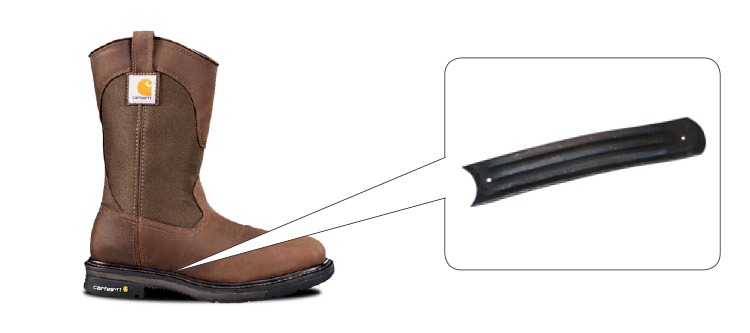If you are familiar with work boots and have been using them for a long time, you should be aware that some of the most significant aspects of your boots are hidden deep inside the structure and are not easily visible.
A shank is an important feature that is responsible for the structure of your work boot.
There are two types of shank available:
1.) Metallic shank or steel toe- made up of thin bits of metal between your work boots.
2.) Non-metallic shank, also known as composite toe

Non-metallic shanks are composite toes made of materials like fiberglass, plastic, nylon, and kevlar.
Because of their structure, they’re apt for people who have to be on their feet for a long time as they’re not as heavy as steel toe boots and are comparatively warm and lightweight. However, they do not compromise on safety no matter their weight.
When it comes to safety and protection from something falling on your feet, I’m sure you’re thinking that a pair of steel-toe boots would be the greatest option. However, don’t be fooled by the materials and weight of composite shanks; they can compete with steel in a head-to-head battle.
In this article, we’re going to discuss the importance of Non-metallic shanks and why they are used, along with some of the things you need to watch out for in composite shank boots.
So What Are The Two Types of Non-Metallic Shanks Used In Safety Boots:
1.) Polycarbonate (PC/PBT) thermoplastic toe caps, which are commonly used in automobile bumpers due to their great impact strength.
2.) Toe caps composed of composite materials are manufactured by impregnating fiberglass sheets with resin. Before being molded into the shape, the materials are layered and then pressed to reduce thickness.
Why are non-metallic shanks important?
1.) They meet the required safety standards
Non-metallic shank boots meet OSHA(Occupational Safety and Health Standards) and ASTM (American Society for Testing and Materials) safety standards and are favored by engineers, electricians, and certain contractors who routinely work in dangerous areas with electrical risks.
2.) They provide good protection
Non-metallic shanks are advantageous for work in situations where there are electrical hazards since the materials used are insulators, which means they will not allow electricity to pass through them.
Reasons that make non-metallic shanks better than metallic ones:
1.) They don’t produce heat as well as steel shank boots, therefore they’re the ultimate choice for working in hot or cold weather. This is why non-metallic shanks are used on extreme cold weather boots.
2.) As compared to steel, they’re 30% lighter in weight because of the materials that are used for their production.
3.) Because of their lightweight and softness, it reduces stress and fatigue for people who spend the majority of their day on their feet.
4.) Anti-penetration midsoles made of non-metallic materials are also softer and more flexible than steel. As a result, during hot temperatures, composite toe boots can be a significant benefit.
5.) With these non-metallic shank boots, you don’t have to worry about the metal detectors going off in airports or any government facilities making them ideal to wear anywhere.
6.) Midsoles in non-metallic shank boots can be readily attached along the whole length of the sole, however, this is not always achievable with metallic shank boots due to the need for elasticity in this area of the shoe. As a result, they are more resistant to nails, screws, and other sharp items.
Gathering all the possible benefits that non-metallic shank boots have to offer, we also need to have a look at the things that you have to be careful about.
See also: Do Wedge Boots have Steel Shank?
So let us have a look at its disadvantages now:
1.) Although non-metallic shank boots are constructed to meet industry standards for acceptable impact and penetration resistance, they often cannot exceed this rating to the same extent as metal.
As a result, if you operate in particularly high-risk areas, they may not provide as much protection because a composite toe cap may crack or shatter if a heavy object falls on it.
2.) Because they are bulkier than metal shank boots, they may not be as good as steel when it comes to standing on rocks and sharp items.
3.) Because of their manufacturing process and architecture, non-metallic shank boots are not as affordable as metallic shank boots.
Here is a comparison chart below that can help you understand the differences better:
| Features | Non-metallic shank | Metallic shank |
| Material | Fiberglass, nylon, hard plastic, kevlar | Steel |
| Weight | 1.7- 4 pounds | 3- 6 pounds |
| Comfort | Excellent | Fair |
| Protection | Meets ASTM safety standards/ Fair | Meets ASTM safety standards/ Excellent |
| Style | Not as variety available | Lots of variety available |
| Safety from electrical hazards | Does not conduct electricity | Conducts electricity |
| Heat and Cold conduct | No | Yes |
Some other factors you should consider before you choose between metallic and non-metallic ones:
1.) The climate of the place where you work-
The working of your metallic and non-metallic shanks is substantially different. As a result, one may prefer specific climates while the other does not. As a result, it is important to select the most beneficial option.
We all work in various locations with varying climates. When it comes to insulation, work boots with metallic shanks are notoriously inadequate in cold areas.
This will have an impact on how your feet feel in your work boots. Whereas work boots with non-metallic shanks are more insulated and will perform better in these conditions. You can operate in extremely cold climates while yet receiving adequate insulation.
2.) The type of environment you work
In your workplace determines a lot of factors that you need to consider. Many aspects that you must consider are determined by your workplace.
Steel shanks can undoubtedly save your life if you work in a heavy machinery environment. Consider the inconvenience if you work in an environment with metal detector passages.
Work boots with composite shanks would be a better choice in this situation as it will make it easier for you to work without having to take off your shoes to pass through.
Similarly, depending on the situation at work, one sort of work boot will be more useful than the other. This all indicates how your options vary depending on the industry in which you work.
Conclusion
Having shanks in your work boots is actually important. Not only does it protect your feet from falling objects, but it also protects and supports your arch.
Non-metallic shank boots are a great choice for people who have to be on their feet for long hours as the pain or discomfort will not distract you from your work.
While both steel and composite shanks have passed safety tests and meet the required criteria, composite shank boots provide significant advantages.
The benefits of a composite toe cap is more than steel shank boots and more, as it is resistant to heat, cold, and electrical conduction.







